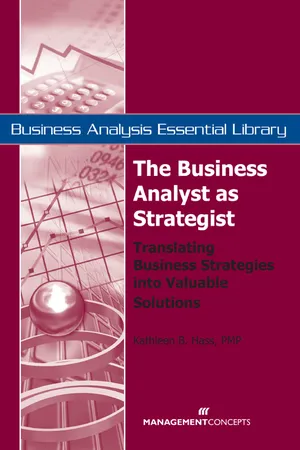
The Business Analyst as Strategist
Translating Business Strategies into Valuable Solutions
- 194 pages
- English
- ePUB (mobile friendly)
- Available on iOS & Android
The Business Analyst as Strategist
Translating Business Strategies into Valuable Solutions
About this book
An organization's ability to achieve strategic goals through programs and supporting projects depends on its ability to establish a future vision, set strategic goals, select the most valuable projects, and then execute flawlessly. Organizational strategic alignment
is achieved by converting strategic plans and goals into a valuable portfolio of programs and supporting projects. Strategic project leaders and project teams execute the project plans to meet objectives and deliver project outcomes, adding value to the organization. As the role of the business analyst evolves and matures, senior business analysts will emerge as the key individuals in the organization who have the depth of business
acumen and technological proficiency to serve as both business and technology experts. In this capacity, business analysts will become involved in an array of activities designed to devise a strategy to reach the organization's future business vision by achieving strategic goals. As the business analyst elevates into a leadership role as the business and technology strategist, he or she serves the executive team by facilitating, informing, and enabling the most favorable business decisions during the strategic planning and enterprise analysis phases of the business solution life cycle (BSLC). This book examines the emerging critical role of the business analyst during these first two phases of the BSLC.
Frequently asked questions
- Essential is ideal for learners and professionals who enjoy exploring a wide range of subjects. Access the Essential Library with 800,000+ trusted titles and best-sellers across business, personal growth, and the humanities. Includes unlimited reading time and Standard Read Aloud voice.
- Complete: Perfect for advanced learners and researchers needing full, unrestricted access. Unlock 1.4M+ books across hundreds of subjects, including academic and specialized titles. The Complete Plan also includes advanced features like Premium Read Aloud and Research Assistant.
Please note we cannot support devices running on iOS 13 and Android 7 or earlier. Learn more about using the app.
Information
Part I
The Business Analyst’s Role in Strategic
Planning and Enterprise Analysis
Chapter 1
The Emerging Role of the Business
Analyst in Strategic Planning
- Strategic Planning in Organizations Today
- The Business Analyst’s Role in Strategic Planning
Strategic Planning in Organizations Today
- Conducting research and presenting findings

- Establishing strategic goals and themes

- Selecting change initiatives

- Measuring progress over time

Conducting Research and Presenting Findings
- Investigating, comparing, and contrasting the organization’s current strategy versus industry trends, marketplace pressures, and competitive threats

- Assessing the current state of the organization’s technology structure, and strategies to ensure that structure aligns with the business vision

- Identifying current business problems...

Table of contents
- Cover
- Title Page
- Copyright
- About the Author
- Table of Contents
- Preface
- About This Book
- Part I - The Business Analyst’s Role in Strategic: Planning and Enterprise Analysis
- Part II - Using Portfolio Management to Achieve: Strategic Goals
- Appendixes
- Index